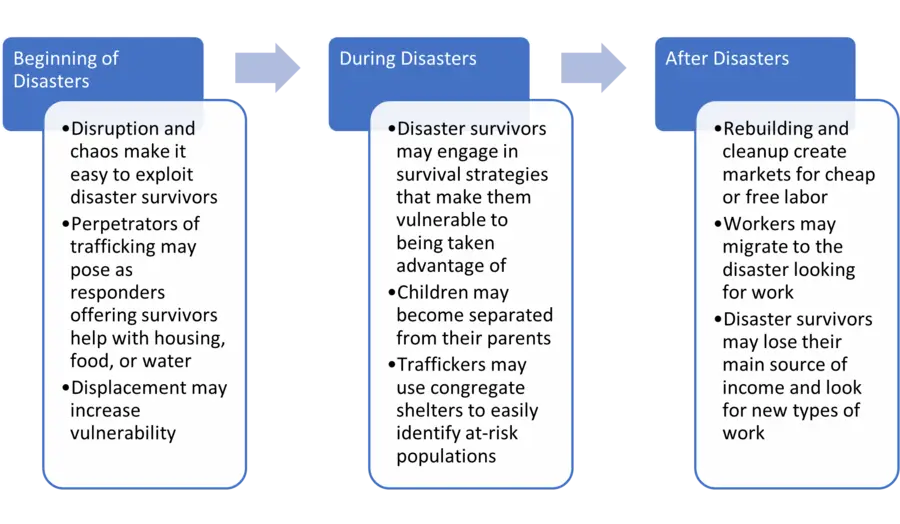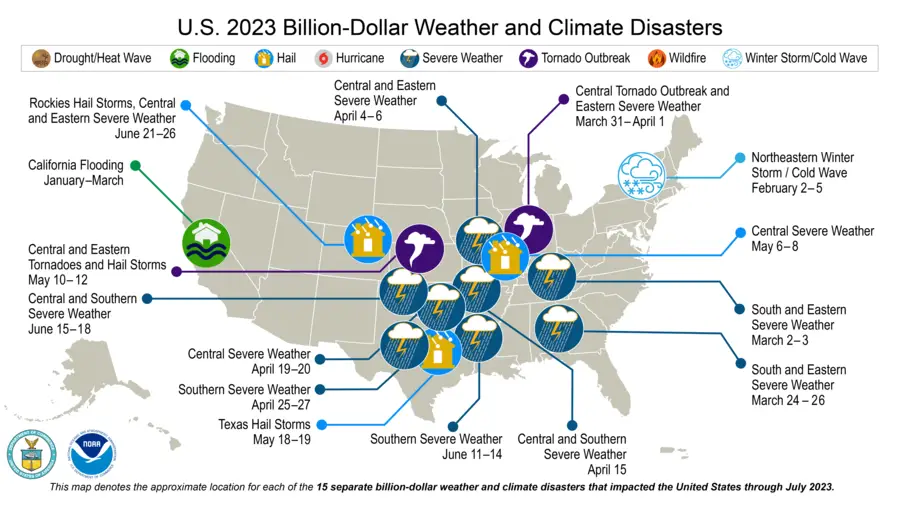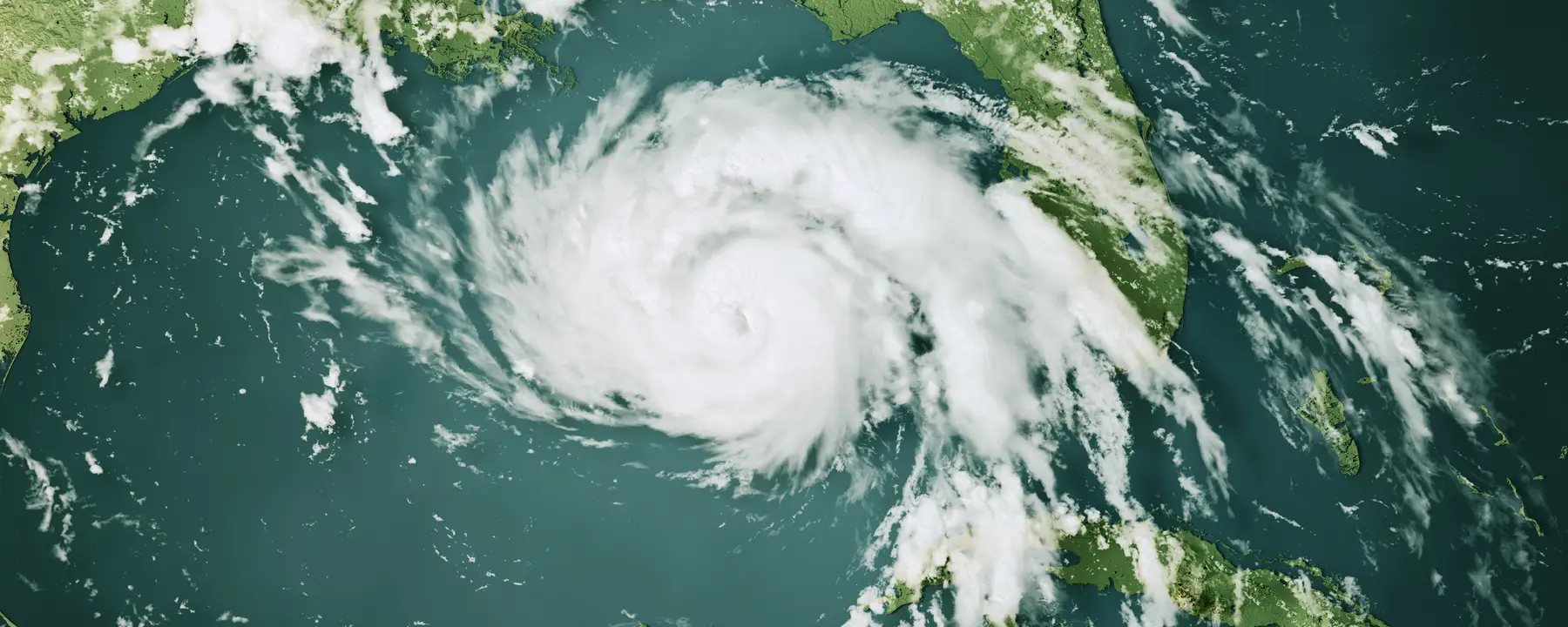Exploring an emerging issue at the intersection of climate change and human trafficking
Objective
To advance our understanding of effective strategies to prepare for and respond to exploitation and abuse in the wake of natural disasters in the United States.
Approach
We use interviews with disaster responders and anti-trafficking professionals to understand how relevant agencies prepared for and responded to the potential for commercial sexual exploitation and labor exploitation before, during, and after the major hurricanes in the Gulf Coast region since 2017.
Impact
Disaster responders and anti-trafficking actors need to be aware of the connection between disasters and human trafficking so that they can implement policies, procedures, and practices for prevention and intervention.
Natural disasters increase the risk of human trafficking and disrupt anti-trafficking efforts
Natural disasters can cause long-lasting, catastrophic damage and trauma to people and their families, homes, and communities. Flooded roads, downed powerlines and trees, evacuations, and reduced access to crucial resources can leave survivors isolated and/or homeless as responders attempt to restore safe conditions and provide aid. These unstable environments may incentivize predatory behavior as those impacted by disasters may engage in risky survival strategies, increasing the pool of potential human trafficking victims (Figure 1). Moreover, jobs in the cleanup and rebuilding efforts post-disaster often rely on a vulnerable migrant workforce and can be highly exploitative.
As climate change increases the severity and frequency of natural disasters, it is critical to understand how agencies prepare for and respond to human trafficking in the wake of these disasters in order to develop evidence-based strategies, policies, and procedures for prevention and intervention.

Figure 1: Disasters Increase the Risks of Human Trafficking. Adapted from Human Trafficking - What Disaster Responders Need to Know Infographic (phe.gov)
Normally, the identification and response to human trafficking is largely the responsibility of law enforcement agencies. During disasters, the systems and infrastructure that are critical to effective policing are disrupted, including staffing, communication, transportation, and collaboration with other agencies. Priorities shift from normal patrol and other proactive duties to a focus on rescue, safety provision, and emergency aid. During the chaotic immediate aftermath of disasters, police are tasked with maintaining safety and order, first and foremost. Understandably, even though human trafficking training is becoming more common among law enforcement officers, that is not a priority after disasters. Moreover, other types of first responders are even less likely to be trained on how to identify and respond to human trafficking.
This combination of an increase in human trafficking and disruption in anti-trafficking efforts creates a particularly dangerous environment for communities already suffering from a disaster. However, this emerging issue has received little empirical attention and evidence-based practices are not yet available.
Climate change is increasing the frequency and severity of natural disasters
Further exacerbating the situation, weather and climate disasters have been increasingly catastrophic in recent years across the United States due to climate change. For example, in 2023 alone, there were 15 natural disaster events by July that caused losses exceeding $1 billion. Tornados, hail, flooding, and winter storms impacted areas ranging from California to the northeast (Figure 2), and in late August Hurricane Idalia caused major damage in the southeast that is still being assessed. The number of these large-scale disasters has also increased: the 1980–2022 annual average was 8.1 events (CPI-adjusted), and the annual average for the most recent 5 years (2018–2022) is 18.0 events (CPI-adjusted).

Figure 2: Billion-Dollar Natural Disasters Impact the Entire U.S. NCEI/NOAA
Collecting data from anti-trafficking and disaster response professionals
Despite growing awareness of the connection between natural disasters and human trafficking, research has not kept up with this emerging issue. We recognized the critical need for evidence-based best practices to effectively prevent and respond to human trafficking in a time of increasingly frequent and severe disasters.
RTI funded this study to provide foundational knowledge needed to move the field forward. This case study focuses on the impact of major hurricanes (category 3 or higher) in the Gulf Coast region since 2017 and their intersections with human trafficking. Specifically, we seek to understand how relevant agencies prepared for and responded to the potential for commercial sexual exploitation and labor exploitation before, during, and after the hurricane.
Data collection consists of interviews with both anti-trafficking and disaster preparation and response professionals who work in or near areas that were impacted by these hurricanes. The interviews focus on the participant’s professional background, community context, collaboration with other agencies and organizations, disaster-specific preparation and response, and how major hurricanes may have impacted the level and type of exploitation that is occurring in the community.
To date, we have interviewed 37 individuals in Louisiana (26 anti-trafficking professionals and 11 disaster response professionals), primarily focusing on their experiences after Hurricanes Laura and Ida.
Findings from the interviews will be used to:
- Describe the nature of human trafficking that has been identified in the wake of recent severe hurricanes that impacted the Gulf Coast, including primary industries and vulnerable populations
- Identify key challenges to addressing human trafficking during and after a disaster
- Highlight promising practices and lessons learned regarding preventing and responding to human trafficking post-disaster
Communities need evidence-based practices to respond to human trafficking in the event of a natural disaster
Natural disasters increase the risk of human trafficking from the beginning of the disaster through the cleanup and recovery effort, impacting both disaster survivors and the cleanup workforce. As natural disasters become more dangerous due to climate change, understanding the connection between natural disasters and the heightened risk of human trafficking is essential for the development and implementation of policies, procedures, and practices for effective prevention and intervention.
Learn more about RTI's human sex and labor trafficking research
- RTI-funded




